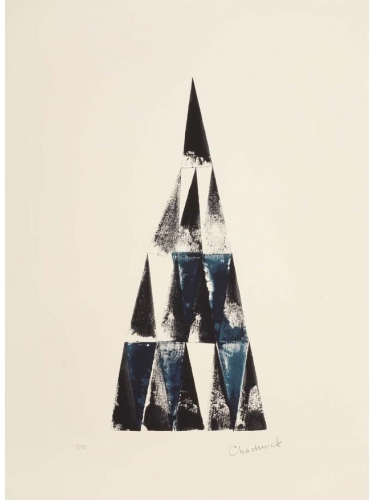
Lynn Chadwick
Prints and Maquettes
11th June - 20th July 2007
It feels strange to be putting together an exhibition of Lynn Chadwick’s work without his input. Four years have passed since his death and it seems appropriate now to reassess his legacy through the intimacy of his maquettes and prints. In these smaller sculptures and graphic works all Chadwick’s great themes are visited. The small scale of the maquettes belies their monumental impact; they are at once precious yet monumental, catching the attention from afar.
Chadwick’s playful control of his abstract sculptural language and how it relates to the figure is clearly demonstrated in this exhibition. Whereas many of his contemporaries were primarily Expressionist or Surrealist, his craftsmanship and rigour for form placed overtly Surreal or Expressionist imagery into a secondary role. This is not to deny expression within his work, far from it, rather that it is not its primary function: the figure is secondary to the formal explorations. Nonetheless, Surrealist imagery is undeniable: Chadwick occasionally harnessed images from his dreams and the witty breastplate of ‘Standing Figure 1988’ shares something with Magritte’s ‘Le Viol’ where a face is simultaneously a body. However, it is also a shield or a mask, or in the polished Electras, a mirror for the observer. This enigmatic sculpture clearly illustrates how Chadwick’s method could be adapted from a geometric construction to a more naturalistic end.
From Pyramid III 1965, a Chadwickian version of a Platonic Solid to ‘Maquette for High Wind’ 1984, at the other extreme, this collection illustrates the astonishing breadth of his sculptural vocabulary. Expression in Chadwick’s sculpture is essentially imparted through his method of construction. The linear profiles of the planar forms are inherently jagged, dynamic, structural elements that he uses to build the vital and energetic whole, making a personal iconography of figures and beasts, their ‘anatomy’ a unique invention, a fusion of the process and his particular imagery.
The prints are a reminder of his graphic talent, given expression in the late thirties and after the War when he was an architectural draughtsman: clean direct line and bold blocks of colour, often using a repeated form to construct an entire image. The relationship between line and shape is a two-dimensional shorthand for the interaction between line and form in his sculpture.
Some prints are direct interpretations of sculpture as a graphic image, others more playful constructions in their own right. Chadwick’s use of shaped blocks, inked and printed on paper in varied juxtaposition,
forming pyramids, figures or beasts, is as simple a printing method as could be devised, reminiscent of the potato print we all practised in our first years of school. It is typical of Chadwick to take such simplicity and subvert it to construct and develop an image. In a similar way, perspective is used to distort or change; again a two-dimensional shorthand for the way descriptive line in his sculpture is fractured in space to create a new profile or a new equivalent in form, another reality.
This selection of sculptures demonstrates a clear progression through Chadwick’s work. In the work of the 1950’s, the complex craggy outlines of the external steel armature defining faceted forms, give rise to fantastic bird/fish/figure amalgams, their forged, welded, modelled and fragmented surfaces the earliest expressions of Chadwick’s unique working method.
During the 1960’s, Chadwick’s construction method was honed to its most essential. Along with everyone else, he was experimenting with abstraction. The armature and modelled surface are still his language, disciplined to its most formal grammar: Platonic Solids, yet always with an organic twist; a sphere fractured, a pyramid perforated, the concept humanised. What were fundamental elements constructing his figures now evolved into expressions of the figure, a playful abstraction, the very opposite of the sculptures of the 1950’s, perhaps ‘the geometry of fun’.
Never one to be typecast, Chadwick’s exploration of the abstract led to another incarnation where the basic forms themselves are combined to create beasts and figures. An association of three pyramids or cubes on legs could provide endlessly variable conjoined forms: Watchers, Beasts and Trigons.
In the 1970’s, he returned to the figure; now the bodies seem softer, while the heads keep their geometric pyramids, squares and diamonds. This combination of modelled figuration and planar elements enables Chadwick to play with form and narrative, abstraction and naturalism. Dynamics are set up between figures, a conversation implied in the way two figures relate to one another.
Chadwick exploited this rich vein, producing many sculptures, well into the 1980’s when the welded sheet metal of the 1960’s reappeared. It now found real expression in the fabricated ‘origami’ beasts and figures where form and material alone create the already familiar images: beasts of polished steel whose planes reflect their environment. Line no longer delineates form; now the planes enclose it. Chadwick tested this new expressive medium to its limits, returning to his very beginnings in sculpture: the mobile reduced to one or very few elements. The ‘Ace of Diamonds’ series includes the dynamic of form and movement often implied in his static sculpture but here brought into reality, changing the interrelationship of the forms and their surroundings.
Looking back over Chadwick’s long working career, the inventiveness and diversity of his sculpture becomes strikingly clear. His personal language and poetry consistently evolved to produce images that are one of the defining expressions of the 20th Century and will always be relevant.
Rungwe Kingdon
May 2007
Photographs by Steve Russell

